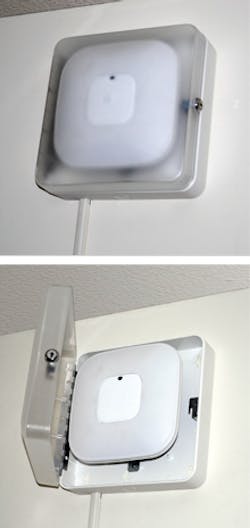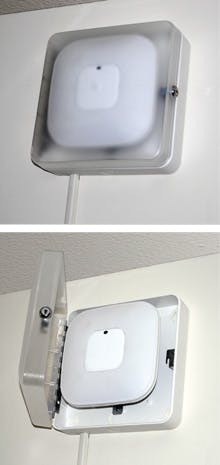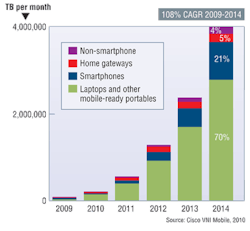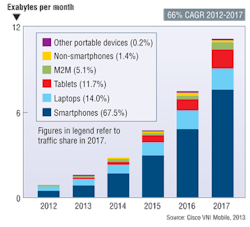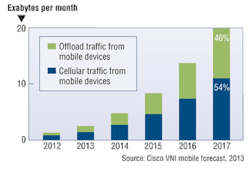New Gigabit wireless to support mobile-data growth
From the September, 2013 Issue of Cabling Installation & Maintenance Magazine
A glimpse into the near future shows the imminent need for high-capability WiFi networks in many types of user environments.
By Scott D. Thompson, Oberon Inc.
In this, the first of a two-part article, I will present a forecast for growth in mobile data requirements, the impact this may have on premises wireless local area networks (LANs), and some infrastructure strategies to handle surges in mobile data consumption. In part two, which will be published next month, I will describe the 802.11ac and 802.11ad amendments to the wireless networking standard, and strategies for using these technologies for Gigabit wireless capabilities.
How often do you access Web-based content or apps from your own mobile device(s)? And how many more mobile devices are in your own personal arsenal now than a year ago? I would bet that you, like most of the world’s inhabitants, are consuming substantially more mobile data than just one year ago, and you own, or pay for, more mobile data-consuming devices than you did a year ago. But has anybody quantified this growth globally? Periodically, Cisco releases the Visual Networking Index: Global Mobile Data Forecast, or VNI. Cisco calls it the Visual forecast, not because of exceptional perception on their part (which, I believe, has been quite good), but because the growth in data consumption is visual content such as video, images, image searches, renderings, photographs and social media.
The VNIs have it
This report is lengthy, but is worth reading, largely because the sheer scale of growth projected must somehow impact the way we conduct business and, quite frankly, our lives. The report forecasts a 66 percent compound annual growth rate (CAGR) of data consumption by mobile devices over the next four years. This doubling in data consumption every 14 months mimics Moore’s prediction (or "law") that says the number of transistors on an integrated circuit will double every two years. I believe it simply follows that our ability to store, process and transport data is allowing consumers to demand the content they really desire. It appears that this demand will not abate for the foreseeable future.
How have past Cisco VNI forecasts performed relative to current actual metrics? Back in 2010, the VNI predicted global mobile data consumption of 1.2 Exabytes per month. (1 Exabyte = 1 million Terabytes = 1 billion Gigabytes), with 108 percent CAGR through 2014. This forecast was probably compiled the year before, in 2009. In 2013, Cisco has released the VNI Update 2012-2017. This report states that global mobile data has actually reached "only" 0.9 Ebytes/month in 2012, with an annual growth rate of "only" 70 percent from the year before. Although these numbers are off somewhat from the forecast (1.2 Ebytes/month and 108 percent, respectively), I still find this growth impressive through years of global recession, and the forecast is really not too far off the mark.
One thing that has changed significantly between the 2010 and 2013 report is the mix of products consuming the data. In the VNI 2010 forecast, the chart shows "laptops and other mobile-ready platforms" (tablets) consuming 70 percent of the data, and smart phones consuming only 21 percent in 2014. The new VNI 2013 forecast shows a near-reversal by 2017--laptops and tablets together consuming just 25.7 percent and smart phones consuming 67.5 percent. The report states that in 2012 mobile video made up more than half the mobile data traffic, and that by the end of 2013, the number of mobile-connected devices will exceed the world’s population and more than half of the consumers of data will be smart phones.
The view from campus
One can always look to college campuses to get a glimpse of future technology uptake in the commercial and business world. Students may own a dozen or more electronic products, and the 2013 EDUCAUSE Center for Applied Research (ECAR) study on bring-your-own-device (BYOD) trends estimates that students will bring three to four wireless Internet-connected devices with them to campus in the fall of 2013. Large network operators, such as college campuses, are seeing a doubling of connected devices in 15-month spans. Some of you may remember Napster, the peer-to-peer file-sharing service used for sharing music. When Napster became immensely popular in the summer of 2000, students returned to their campuses that fall and overwhelmed many campuses’ Internet and premises-network capabilities. Some network administrators believe that 2013 may bring similar challenges to campus WiFi networks.
The number of network-connected devices used by students is larger than ever, and most of them may be connected to the network wirelessly. A survey by ACUTA (www.acuta.org), a higher-education communications association, asked higher-education leadership which devices will impact bandwidth consumption in coming years. The results indicated that tablets, such as the iPad, wirelessly connected PCs, video gateways, smart phones and a number of other devices are expected to significantly impact bandwidth consumption most in the coming years.
In many schools the WiFi bandwidth demands are such that the wireless access points (WAPs) are closely spaced, especially in residence halls. Many schools are putting a WAP into each residence hall room. (This is where multiple cable drops per room come in handy.) High-density WAP placement and installation in residence halls presents its own set of challenges, including how to secure the WAP, and how to make the WAP and its associated cabling unobtrusive, in areas with hard-lid ceilings and block walls.
Public venues
Another "glimpse into the future" can be obtained by looking at how wireless networks are being deployed in large public venues such as stadiums and auditoriums. At one time, using your cell phone in the stadium was a distraction. Now entertainment venues are actively promoting smart phone use for real-time game statistics, game highlights, athlete information, ticketing, vendor order fulfillment and so on. These wireless networks must support potentially thousands of simultaneous users in small areas.
In these venues, WAP and DAS antenna density must be high in order to support all the users and their bandwidth demands. Stadiums and auditoriums do not have convenient suspended ceilings in which to place WAPs, so high-density WAP placement is a challenge. Many venues are now installing WAPs beneath the seating, either in or on the floor, risers, or directly under the seating. This approach is appealing because the presence of many human bodies helps to control the WiFi signal propagation so that WAPs can be more densely spaced without interfering with each other. Of course, the WAPs and their associated cabling need to be protected from weather, spilling liquids, high-pressure spray wash and physical impact if they are mounted under the seating. A NEMA 4-rated outdoor enclosure will adequately protect the WAP.
Clearly the demand for pervasive mobile data coverage will put stress on wireless infrastructure. How will this mobile data be transported? What wireless network, and its wireline infrastructure, is up to the task? The answer is that most wireless networks, both service provider (SP) cellular and private wireless LAN (WiFi) networks are struggling with capacity issues. The SP cellular networks are very clearly bandwidth-limited, especially in urban areas, and the SPs are actively seeking ways to squeeze maximum capacity out of their limited spectrum, or better yet, "offload" cellular traffic onto available WiFi networks. Cellular offload to a WiFi network helps for the following reasons. 1) WiFi uses unlicensed spectrum, thereby freeing up the SPs’ precious licensed spectrum. 2) There is much more bandwidth, especially in the 5-GHz band, in a WiFi network than in the SP’s spectrum holdings. 3) WiFi is available, either as a premises wireless LAN or WiFi hotspot, in just about every building. Because most data access is going to be in or near a WiFi-enabled building, traffic can feasibly be offloaded. The Cisco 2013 VNI report weighs in on this topic. The VNI states, "As a percentage of total mobile traffic from all mobile-connected devices, mobile offloaded increases from 33 percent (0.43 Exabytes/month) in 2012 to 46 percent (9.6 Exabytes/month) in 2017." This is a growth factor of more than 20 times in just five years.
So by 2017, almost half of the mobile data is offloaded onto the WiFi network. The WiFi networks will be a combination of private wireless LANs (commercial and residential) and SP "hotspots." Although there are challenges in handing off an active phone call from a cellular network to a private wireless LAN, newer smart phones and tablets actively seek available and authorized WiFi networks to which to connect. In this manner the big bandwidth-consuming sessions, such as video downloads, are natively offloaded to the WiFi network. Newer smart phones use power-efficient network-search algorithms and exploit WiFi’s 5-GHz band.
Commercial WiFi networks--initially designed for casual Internet access, limited guest access and periodic conference room use--will be promoted to more of a mission-critical role, requiring improved throughput and connection reliability. Part of this improvement in performance will come from architecture and infrastructure improvements as described. However, there needs to be significant advance in the capability of the wireless equipment, just as data cabling rates have advanced.
Fortunately, the Institute of Electrical and Electronics Engineers (IEEE: www.ieee.org) and industry participants have been working to create amendments to the 1997 IEEE 802.11 specification for wireless networking. These new IEEE amendments, specifically IEEE 802.11ac and 802.11ad, are intended to support Gigabit networking with an emphasis on video and multimedia content.
More detail next month. ::
Scott D. Thompson is president of Oberon Inc. (www.oberonwireless.com).
Archived CIM Issues
